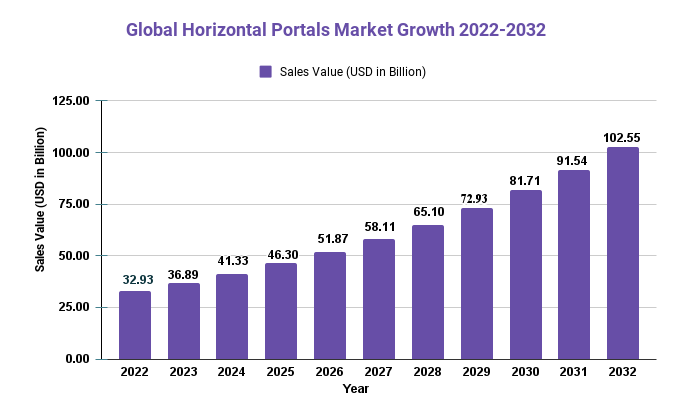Horizontal Portals Market: Growing at a CAGR of [12.03%] – Key Trends and Marketing Insights for Enterprises
Page Contents
Market Overview
Published Via 11Press: Horizontal Portals are software solutions that give organizations a single point of access to multiple applications, content, and services across an enterprise. The global Horizontal Portals market has seen considerable growth over the last few years and is projected to keep growing steadily throughout the forecast period.
In 2022, the global Horizontal Portals market size was valued at USD 32.93 billion and is projected to reach a value of USD 102.55 billion by 2032 with an annual compound growth rate (CAGR) of 12.03% from 2022-2032.
The Horizontal Portals market is experiencing rapid growth due to increasing demand for personalized and seamless customer experiences, the rising adoption of digital technologies, and the need for efficient content management and collaboration within enterprises. Furthermore, the growing trend towards digitization coupled with an increasing number of small and medium-sized enterprises (SMEs) are expected to present significant growth opportunities to Horizontal Portal vendors.

We Have Recent Updates of the Market in Sample Copy@ https://market.us/report/horizontal-portals-market/request-sample
Regional Snapshot
- North America: North America is expected to dominate the Horizontal Portals market during the forecast period. This region boasts a high adoption of digital technologies and many key market players are driving growth within this region. Furthermore, an increasing demand for personalized customer experiences is fueling market expansion within this region.
- Europe: The Horizontal Portals market in Europe is projected to experience substantial growth over the forecast period. The region boasts a large number of small and medium-sized enterprises (SMEs) that are increasingly utilizing digital technologies for efficiency in operations as well as improved customer experiences.
- Asia-Pacific: The Asia-Pacific region is expected to experience the highest growth rate in Horizontal Portals during the forecast period. This region's rising adoption of digital technologies, expanding e-commerce sector, and rising demand for personalized customer experiences are some of the major factors fueling market expansion there.
- Middle East and Africa: The Horizontal Portals market in the Middle East and Africa region is expected to experience moderate growth over the forecast period. With the increasing adoption of digital technologies and an increased need for efficient content management systems, demand for this market is expected to surge within this region.
- Latin America: The Horizontal Portals market in Latin America is expected to experience moderate growth over the forecast period. The region is witnessing an increasing adoption of digital technologies, leading to an increasing need for efficient content management and collaboration across enterprises – which will fuel market expansion within this region.
Drivers
- Need for Digital Transformation: Enterprises are increasingly adopting digital technologies to streamline their operations and enhance customer experiences. Horizontal Portals provide a centralized platform that enables enterprises to manage multiple applications and services, making digitization much simpler.
- Customer Expectations for Personalized Experiences: Customers today expect personalized and seamless experiences across all touchpoints. Horizontal Portals enable enterprises to provide one centralized access point to multiple applications and services, making it simpler for them to deliver tailored experiences for their customers.
- Growing Trend of Mobile and Remote Working: As more employees opt for flexible working, many are choosing to work from home or on the go. Horizontal Portals provide a centralized platform that enables employees to access all applications and services remotely, making it simpler for them to stay productive while away from their desks.
- Enterprises need effective content management and collaboration: Businesses generate and consume vast amounts of data, necessitating them to organize, monitor, and collaborate on content efficiently. Horizontal Portals help enterprises accomplish this task more quickly by offering a centralized platform that integrates multiple applications and services.
- An increasing number of small and medium-sized enterprises (SMEs): SMEs are adopting digital technologies to streamline their operations and enhance customer experiences. Horizontal Portals offer a cost-effective solution for SMEs to manage multiple applications and services, making digitization much simpler for them.
Restraints
- High Implementation and Upkeep Costs: Establishing Horizontal Portals can be expensive, especially for small to medium-sized enterprises (SMEs) with limited budgets. This may present a barrier to adoption for some firms.
- Security Concerns: Horizontal Portals offer a centralized platform that integrates multiple applications and services, leaving them vulnerable to security risks. Enterprises should take steps to ensure their Horizontal Portals are secure and their data protected from cyber attacks.
- Lack of Technical Competence: Constructing and supporting Horizontal Portals necessitates technical proficiency, which may present a challenge to some enterprises. They may need to hire or train staff with the necessary skillset which would add significantly to the cost and time necessary for implementation.
- Integration Challenges: Integrating multiple applications and services onto a single platform can be tricky, particularly when working with legacy systems. Enterprises may need to invest in additional tools and technologies for seamless integration, increasing both the cost and complexity of implementation.
- Resistance to Change: Some enterprises may be unwilling to adopt Horizontal Portals, even if they provide significant advantages in terms of efficiency and customer experience. This can be a barrier for adoption even if organizations show signs of openness to innovation.
Opportunities
- Cloud-based solutions in demand: There is a growing trend towards cloud solutions. More enterprises are opting for cloud-based technologies to reduce their costs and streamline their operations. Horizontal Portals can also be hosted on the cloud. This allows for scalability and flexibility as well as cost-effectiveness.
- A growing focus on customer experience: Enterprises place more emphasis on creating exceptional customer experiences. Horizontal Portals are a way for enterprises to give customers seamless, personalized experiences by providing a single point to access multiple applications and services.
- The emergence of machine learning and artificial intelligence (AI), technologies: AI/ML technologies are becoming more integrated into enterprise software, opening up new opportunities for automation, personalization, efficiency, and productivity. Horizontal Portals have the potential to leverage these technologies in order to increase their capabilities and offer more value for enterprises.
- Remote and mobile working is becoming more popular: More employees are working remotely or at home. Horizontal Portals provide employees with a central platform that allows them to access all the services and applications they need, from any location. This makes it easy to work remotely.
- An increasing number of small- and medium-sized businesses (SMEs): This is especially true in emerging economies. Horizontal Portals are a cost-effective way for SMEs to manage multiple services and applications. This makes it easier for them to digitize their business and improve their customer experience.
View Detailed TOC of the Report | https://market.us/report/horizontal-portals-market/table-of-content/
Challenges
- Competition: The Horizontal Portals market is becoming more and more crowded with vendors offering similar solutions. Enterprises may find it challenging to select the right vendor and solution that meets their individual requirements.
- Integrating Horizontal Portals with Legacy Systems: Integrating Horizontal Portals with legacy systems can be a difficult task, particularly when dealing with outdated technology and complex architectures. Enterprises may need to invest in additional tools and technologies for seamless integration, which adds cost and complexity to the implementation.
- Securing Scalability and Flexibility: As enterprises grow and transform, they require a solution that can adapt to their evolving requirements. Horizontal Portals should be designed with this in mind to offer both scalability and adaptability so enterprises can grow as necessary.
- Ensuring Data Security and Privacy: Horizontal Portals offer a centralized platform that integrates multiple applications and services, leaving them vulnerable to security breaches. Enterprises must take steps to make their Horizontal Portals secure, as well as protect their data from cyber-attacks.
- Maintaining Technological Advancements: The technology landscape is ever-evolving, with new tools and technologies popping up every day. Horizontal Portals must stay abreast of these innovations to stay competitive and provide value to enterprises.
Key Market Segments
Type
- Software
- Services
Application
- Telecom and IT
- Healthcare
- Military
- Automotive
- Consumer Electronics
- Other
Key Market Players
- Liferay
- Oracle
- IBM
- Adobe Systems
- Backbase
- Hippo B.V
- Episerver
- Jahia Solutions
- Kentico Software
- Salesforce
- Sitecore
Report Scope
| Report Attribute | Details |
| The market size value in 2022 | USD 32.93 Bn |
| Revenue forecast by 2032 | USD 102.55 Bn |
| Growth Rate | CAGR Of 12.03% |
| Regions Covered | North America, Europe, Asia Pacific, Latin America, and Middle East & Africa, and Rest of the World |
| Historical Years | 2017-2022 |
| Base Year | 2022 |
| Estimated Year | 2023 |
| Short-Term Projection Year | 2028 |
| Long-Term Projected Year | 2032 |
Frequently Asked Question
Q: What is the current market size for the Horizontal Portals Market?
A: According to a report by Market.us, the Horizontal Portals Market was valued at USD 32.93 billion in 2022 and is expected to reach USD 102.55 billion by 2032, growing at a CAGR of 12.03% during the forecast period.
Q: What are the key segments of the Horizontal Portals Market?
A: The Horizontal Portals Market can be segmented based on Type (Software, Services), By Application (Telecom and IT, Healthcare, Military, Automotive, Consumer Electronics, Other), and by geography (North America, Europe, Asia-Pacific, Latin America, and Middle East & Africa).
Q: Who are the key players in the Horizontal Portals Market?
A: Some of the key players in the Horizontal Portals Market include Liferay, Oracle, IBM, Adobe Systems, Backbase, Hippo B.V, Episerver, Jahia Solutions, Kentico Software, Salesforce, and Sitecore.
The team behind market.us, marketresearch.biz, market.biz and more. Our purpose is to keep our customers ahead of the game with regard to the markets. They may fluctuate up or down, but we will help you to stay ahead of the curve in these market fluctuations. Our consistent growth and ability to deliver in-depth analyses and market insight has engaged genuine market players. They have faith in us to offer the data and information they require to make balanced and decisive marketing decisions.



